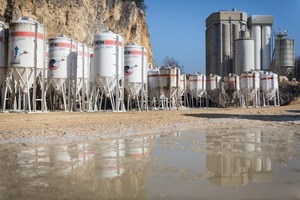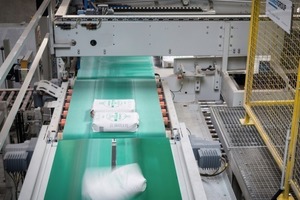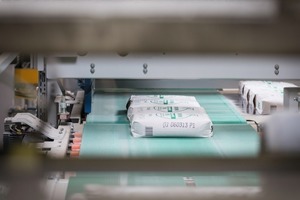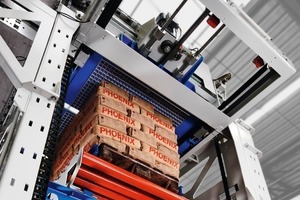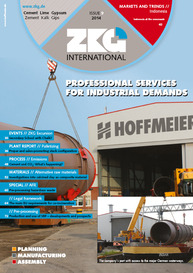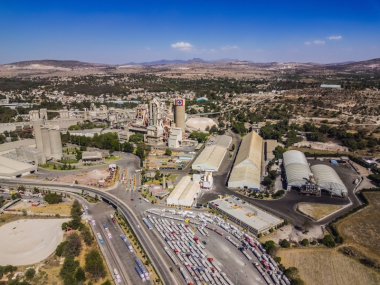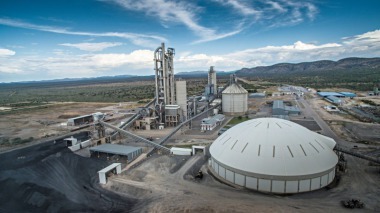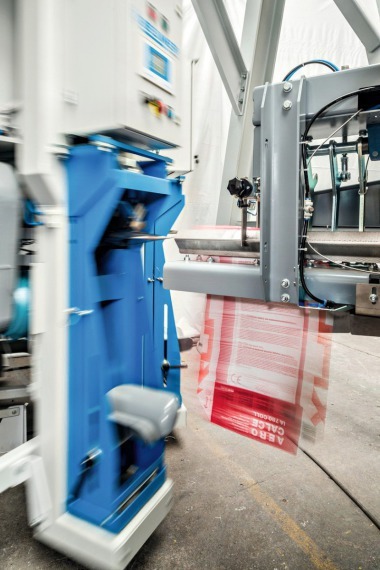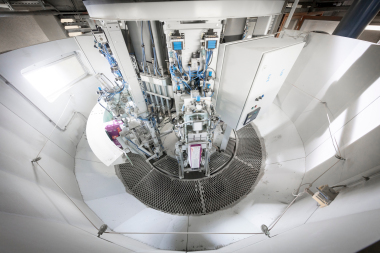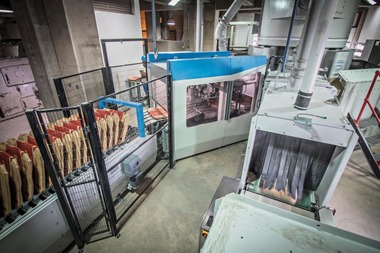Proper and sales-promoting stack configuration
1 Introduction
Dry mortars are prefabricated mixtures composed of mineral binding agents such as cement, limestone, gypsum as well as sand, rock dust and further additives. On the building site the craftsmen have to merely mix them with water and they are ready for use. Owing to the avoidance of possible mixing errors, the producer can ensure a constant high product quality of this building material. Schwenk Putztechnik GmbH & Co. KG headquartered in Ulm/Germany is one of the leading manufacturers of sustainable and ecological dry mortar. The company has produced its materials for more than 160 years in seven ultra-modern plants. “We place great importance on presenting our products optimally in the building material trade,” says Martin Markus. At Schwenk Putztechnik he manages the plants in Eigeltingen and Allmendingen (Fig. 1) in Baden-Württemberg. As regards the manufacturing process, the company focuses on trouble-free transport, palletising process and packaging.
2 Safe handling of bags
“Our previous palletising solutions caused considerable problems during the turning of bags,” remembers Peter Richter, deputy factory manager in Allmendingen. “Due to jerky movements the bags were deformed and sometimes even torn,” he says. The building material manufacturer was not able to ensure a proper and constant appearance of the palletised bags. Schwenk Putztechnik not only wanted to achieve an improved and steady stacking result, but also wanted to increase the production capacity, reduce the dust emissions and prolong the maintenance intervals.
During their researches for a suitable supplier, the building material manufacturer found the Beumer Group. The single-source provider from Beckum supplies sustainable systems for filling, palletising and packaging technology from one source. The leading internationally active company can look back on years of experience in the building material industry. “In cooperation with Schwenk Putztechnik we developed a solution which covers the requirements of both production plants,” Peter Schmidt reports. As sales manager he was responsible for the project and has managed since January 2014 the Palletising and Packaging Technology business segment at the Beumer Group.
3 Gentle palletising is ensured
Beumer presented the high-capacity layer palletiser type paletpac (Fig. 2) to the building material manufacturer. This construction series enables the stacking of filled with bulk material on pallets exactly layer by layer. Due to the geometric precision during layer and stack formation, stable bag stacks are formed. Beumer supplied a system able to palletise 1800 bags per hour as well as a system with a capacity of 2500 bags per hour. In both plants the employees can adapt the palletiser quickly and easily to different bag sizes without the use of tools. With a pack height of up to 2400 millimetres, the paletpac stacks bags on any commonly used pallet size and in all technically possible packing patterns. A multi-program interface enables the user to set parameters easily and quickly. The new Beumer Human Machine Interface (HMI) ensures a user-friendly operation of the system. This control terminal provides the employee with an easily understandable and intuitive interaction, enabling the user to learn the system very rapidly and to define efficient working sequences after just a short training and introduction period.
4 Stable stack formation
“In order to turn the bags rapidly and gently to the required position ensuring their dimensional stability, the systems are provided with our newly developed twin-belt turning device (Fig. 3). With regard to the stackability, this device offers an immense advantage when compared with conventional turning processes,” Peter Schmidt explains. The system component moves the bags without stressing them from a mechanical viewpoint. Instead, two belt conveyors driven in parallel are used, which during the turning process are driven at different speeds bringing the bags gently into the desired position.
The intelligent control of the twin-belt turning device involves the physical properties of the items to be packed in order to achieve an exact positioning preset by the respective packing pattern (Fig. 4). In case of changes in bag sizes, all relevant parameters are registered and controlled just via software. For this, the system reverts to an active control loop. The regulation of the drives is carried out by frequency converters, thus developing a gentle, regular rotation and ensuring that the bagged products are not deformed. This results in constant stack results for the whole service life of the system. Ready packed pallets can be stacked on top of each other in space-saving and safe way.
A further advantage is that time-consuming modifications in case of changed bag sizes are no longer required. “The operator only has to enter the bag length and the bag width. Then the system brings the bag into the corresponding position,” explains Bernhard Temming, service manager at Beumer. Thanks to the modular structure, the twin-belt turning device can be retrofitted even in already existing palletising systems in a quick and trouble-free way.
5 Quiet and efficient
A further reason for Schwenk Putztechnik to opt for the Beumer systems was their efficient operation. In addition to capital costs, operational costs, spare parts costs and also maintenance costs play an important role. “These are better reduced with the twin-belt turning device than with other turning devices,” recognises service manager Bernhard Temming. “The mere automated product change avoids idle times,” and as the system component abstains from cost-intensive mechanical components, this optimises the maintenance and repair costs in the long term and reduces the life-cycle costs.
Comparable solutions of competitors for the layer preparation rely on pneumatic elements with correspondingly high operational costs. “In our twin-belt turning devices the work is done by energy efficient synchronous servomotors,” explains Temming. The relinquishment of mechanical parts additionally lowers noise during operation. Peter Schmidt is convinced that this is a strength that happens especially in the day-to-day operations, providing for an improved working atmosphere and inuring to the benefit of the skilled personnel of the building material manufacturer in the daily working sequence.
For this project Beumer took over the whole handling - from projection up to installation. The experts at Customer Support were responsible of the optimisation and maintenance of the systems, therefore, they were always available. In case of acute problems, the building material manufacturer can contact the Beumer Hotline around the clock. An online connection with the machine permits the carrying out of rapid fault analyses.

